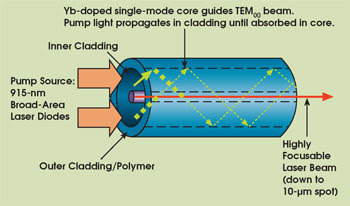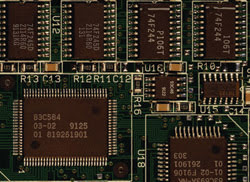Low cost of ownership, compact size and ease of integration could give these lasers a competitive edge in applications such as micromachining.
Andrew Leuzinger, JDS Uniphase
The current generation of fiber lasers offer benefits such as low cost of ownership, compact size and ease of integration, which already make them competitive with YAG lasers, especially in materials processing. As this technology and its potential benefits become more familiar to industry at large, end users should expect more fiber laser vendors to emerge on the scene, followed by a trend toward increased laser power and greater market infiltration.

Because of their design, fiber lasers can allow flexible laser processing such as microbending and -welding within tightly confined work envelopes.
A fiber laser generally consists of a pump source — often involving multiple laser diodes — that is coupled to a double-clad optical fiber. This fiber has an inner single-mode core doped with a rare-earth element such as ytterbium and an outer multimode core in which the pump light can propagate until fully absorbed in the inner core. The single-mode core essentially acts as the laser cavity, with the pump light that passes through it creating an inversion in the ytterbium. Such designs typically use Bragg gratings to function as end mirrors.
Although fiber laser research dates back to the 1980s, SDL Inc. (now JDS Uniphase) and Polaroid Corp. jointly developed the first commercial systems in the early 1990s for the reprographics market. Erbium-doped fiber amplifiers and Raman amplifiers, which are close cousins of fiber lasers, soon followed for telecom applications. Some industry watchers expect the next noticeable market infiltration to be in materials processing.
The first area where the technology will gain a foothold will most likely be micromachining applications such as welding, selective soldering, precision cutting and microbending. One reason for this is its TEM00 circular output beam, which can be focused to a very tight spot. For example, current systems can produce spot sizes down to 5 μm with working distances of 50 to 100 mm. This should increasingly give this type of laser an edge in applications where tight work spaces cannot accommodate conventional laser heads near the surface to be machined.
Typical optical-to-optical efficiencies range from 60 to 70 percent. The corresponding efficiency is about 30 to 40 percent for diode-pumped solid-state lasers and less than 5 percent with lamp-pumped systems. The higher efficiency translates into less diode power for comparable output powers.
This means that pump diodes generate less heat and that relatively high power fiber lasers (more than 25 W) can be cooled with forced air rather than with water. Compared with water cooling, air cooling directly translates to easier integration, less power consumption, fewer components to maintain and a smaller footprint.
Another trend is to use multiple single-emitter diodes rather than bar diodes for pumping. Although the cost per watt of single emitters is greater than that of comparable bar diodes, it is largely offset by higher optical-to-optical efficiencies. In the future, the relative cost per watt of pump power may narrow or even favor single emitters. For now, this strategy has some basic advantages, including mean time before failure of about 100,000 hours for individual diodes. When an emitter fails on a bar diode, the entire bar fails. Also, because of its packaging, bar diodes are susceptible to failing when the power is cycled on and off; single emitters do not have this problem.
End users can expect continued efforts to boost power in coming months. Single-mode power as high as 100 W is available, and multimode fiber lasers offering more than a kilowatt are in early deployment.
Standard diode-pumped solid-state lasers will most likely remain the primary competition for the near term, but their lower efficiencies and need for water cooling lead to added expense and larger packaging. Unlike a fiber laser, with its cavity contained in glass, these designs also face potential problems with cavity contamination. Although CO2 lasers also could be considered competitive with CW fiber lasers, the wavelength difference (10 μm vs. 1 μm with fiber lasers) makes the two laser types suitable for different applications.
Other emerging precision applications include identification matrix engraving and marking of materials such as plastics, ceramics and metals, even anodized and coated materials. A CW fiber laser leaves no intrusive marks, which is particularly important when marking semiconductor packages with a very thin molding compound layer applied over the die and wire bonds. A pulsed laser, though, with its high energy and short pulse widths, may mark the material to a nonuniform depth, causing marking variability and possibly introducing strain that could compromise component performance and lifetime.
Besides the compact nature of the laser source and supply electronics, the fiber delivery of the single-mode beam facilitates laser alignment and integration into many types of equipment and system setups, which can vary depending on the application being performed, the space available on the shop floor and other factors. Conventional technologies such as CO2 and YAG, on the other hand, can still require sensitive and time-consuming free-space alignment.

CW fiber lasers produce a uniform mark for precision marking applications on many surfaces.
Despite its benefits, the technology still has limitations. Current Q-switched fiber lasers are limited in terms of peak power. In addition, the purchase price of CW fiber lasers remains relatively high compared with CO2 lasers that have similar power levels. Nevertheless, fiber lasers are a new class of diode-pumped solid-state laser with the potential to infiltrate some applications where they will compete head-on with conventional lasers.
In addition, their unique design and capability for very high power single-mode output should increasingly expand their use to applications that other industrial lasers cannot support at this time.
Meet the author
Andrew Leuzinger is a product line manager with JDS Uniphase in Santa Rosa, Calif.